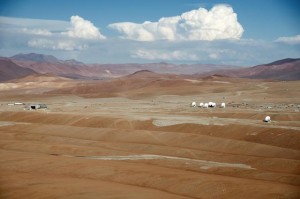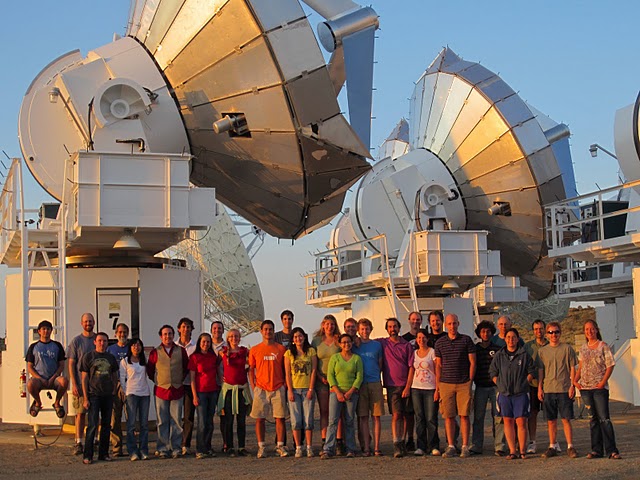During the three months that I worked as a visitor in the “Commissioning and Science Verification” group at ALMA, I had the opportunity to spend four week-long “turnos” (shifts) in northern Chile at the ALMA Operations Support Facility (OSF), where the antennas are operated. If you’re interested to learn more about ALMA, you can check out the webpage, or my two previous posts about my experiences during turnos at ALMA. For some of the early science results from ALMA, check out these astrobites.
Scientifically and personally, ALMA is an interesting and inspiring place to work. Making observations and then analyzing data, I worked with a number of people with a variety of positions and expertise. At the end of a recent turno I asked them a few simple questions to get a better idea of what a job at ALMA entails. Below are their responses (to the questions in bold), which represent just one sample of perspectives, but to me are sufficiently interesting and demonstrate the diversity and complexity of this project.

A view of the ALMA Array Operations Site (AOS), located at 5000 m elevation on the Chajnantor Plateau in northern Chile. (Photo credit: ALMA/ESO/NAOJ/NRAO, W. Garnier)
1. How long have you worked at ALMA? What is your position/title here?
At any given time at the OSF, a team of ALMA staff work together to tackle all aspects of the system. Job titles (for those interviewed here) at ALMA include commissioning scientist, data analyst and system astronomer. ALMA is an international partnership of Europe, North America and East Asia in cooperation with the Republic of Chile, so the control room is nearly always staffed with a very diverse group of people from around the world. Many organizations contribute funding and personnel for the project.
One of the scientists whom I met on my last turno is a member of Academia Sinica Institute of Astronomy and Astrophysics (ASIAA), and will be in Chile for several months to participate in commissioning and science verification on behalf of the East Asia partner. Others with whom I worked bring nearly 6 years of experience with the ALMA project, beginning with testing the ALMA system and antenna prototypes at the National Radio Astronomy Observatory (NRAO) in Charlottesville (VA) and Socorro (NM). The Joint ALMA Observatory (JAO) in Chile provides the unified leadership and management of the construction, commissioning and operation of ALMA, and coordinates the diverse group of people who arrive from around the world to develop the project in Northern Chile.
2. What did you study, and where have you worked before coming to ALMA?
One astronomer told me that one of his favorite parts of ALMA is “getting to work with so many experts and people from all over the world. One gets to learn a lot, not only from radio interferometry but also from the different cultural backgrounds. Since my undergrad, I always knew I wanted to work for ALMA, so I feel very grateful to be here.”
So you think that you might be interested to one day work at an observatory like ALMA? What type of education and training will help you land a job at an observatory? From my small sample, I gathered that a bachelor degree in astronomy and astrophysics, physics and/or mathematics is a useful first step.
One data analyst at ALMA has previously worked as observatory coordinator at a university in Chile, and is also involved as research assistant in one of the European Southern Observatory (ESO) large public surveys currently being carried out with the VISTA telescope at Cerro Paranal.
Those with astronomer positions have PhDs in (you guessed it) astronomy. One interesting note is that among four people, these degrees and jobs have been held in five distinct countries (in fact, five distinct continents). After the PhD, these scientists sought post-doc positions with direct involvement in observatory development and/or operations, mostly (but not all) which observe at mm- and sub-mm frequencies.

The ALMA array beginning to take shape. Soon, 66 antennas will populate the Chajnantor Plateau. (Photo credit: Ignacio Toledo)
3. What is your favorite part of working at ALMA?
“It’s right at the cutting edge – the only place to be if you like millimeter astronomy. Also the Atacama is always an amazing place to work. And you can’t beat seeing Aconcagua out of the window on the Monday morning commute.”
Talking with others working in the control room, I’m inspired by the passion that accompanies this job, for both the science and the diverse work environment. One colleague told me, “Since my childhood I had always dreamed of working at one of the big observatories in Chile; for me this [data analyst at ALMA] is an ideal job. And my favorite part is that I can actually help to increase our knowledge of the universe.”
Working at the Operations Support Facility (OSF), one gains experience with both the scientific and technical aspects of the observatory, as well as the observational data which need to be analyzed. Combining all aspects gives a clearer, first-hand view of what (and how) ALMA is doing.
Granted, there are many challenges to ensure the observatory is operating as planned. Even these challenges are considered some of the favorite aspects of working at ALMA, in part because with new challenges come new advances. Some of the technologies for ALMA have existed before, but the size (66 antennas, over distances spanning 16 km) and frequency coverage (30 GHz to 950 GHz, corresponding to “mm and sub-mm” wavelengths of 0.003 to 0.0003 meters) of the array are unprecedented.
4. What is the most challenging part of working at ALMA?
Of course, an important part of the job at ALMA is dealing with the new challenges which make the project exciting. Many technical issues arise which require knowledge of some combination of instrumentation and programming, and even becoming familiar with the terminology takes time and experience.
Some of the scientists and data analysts have experience with millimeter interferometry, but for those who previously worked with other types of astronomy, including optical and near-IR observations, it has been important to learn some of the finer aspects of radio/mm/sub-mm astronomy at the heart of ALMA.
Add to these challenges the elevation (the OSF is at an elevation of about 3000 meters, or 10,000 feet, while the AOS is at 5000 meters, or 16,000 feet), some isolation and strange work schedule, and even human interactions can become a bit more difficult. Keeping a clear head when things don’t work properly, debugging problems, or simply working with colleagues from different cultures challenges the ALMA staff to grow into better, more tolerant people.
While it can be hard to get enough quality sleep during a turno due to the altitude, the dry climate, and sun peeking through the dorm windows while you try to sleep during the day, one scientist even cites the excitement of her work as keeping her in the control room for longer hours than the assigned shift. Indeed, ALMA operates 24 hours per day, and many of those who work at ALMA are motivated to be a part of the operations nearly around the clock.

A "different" type of telescope at ALMA, being used to observe the partial solar eclipse of July 7th 2010. (Photo credit: Diah Gunawan)
5. What do you hope will be the greatest accomplishment of ALMA?
It’s the hope and belief at ALMA that many great accomplishments will come from all of this hard work. ALMA has already accomplished the feat of becoming the largest astronomy project in the world, a huge array of 66 antennae working together to mimic a telescope with diameter of 16 kilometers, with a goal to explore the universe with incredible resolution (being able to resolve details of size 0.004 arcseconds, or the apparent size of a truck at the distance of the Moon).
ALMA will help increase understanding of (among other things) possible scenarios for star formation, how life emerged on Earth, and how life might have formed/form elsewhere in the Universe. Hopefully, some of you who read this post will use ALMA to make many more discoveries beyond those even imaginable during the construction phase of the project. These goals motivate the ALMA team to develop and perfect its capabilities, which will become a facility available to radio and non-radio astronomers alike.
Disclaimer: The personal opinions and views expressed here are mine (and my understanding of those who responded to my questions), and do not necessarily represent those of ALMA or Fulbright.





Trackbacks/Pingbacks